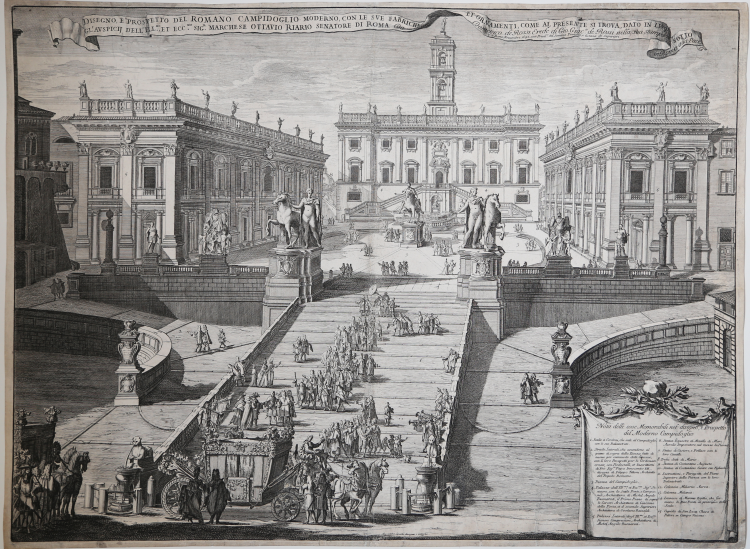




| Reference: | S35056 |
| Author | Alessandro SPECCHI |
| Year: | 1692 |
| Zone: | Campidoglio |
| Printed: | Rome |
| Measures: | 665 x 490 mm |



| Reference: | S35056 |
| Author | Alessandro SPECCHI |
| Year: | 1692 |
| Zone: | Campidoglio |
| Printed: | Rome |
| Measures: | 665 x 490 mm |
Disegno, e prospetto del romano Campidoglio moderno, con le sue fabriche et ornamenti, come al presente si trova, dato in luce sotto gl'auspicij dell'Ill.mo, et Ecc.mo Sig. Marchese Ottavio Riario senatore di Roma da Domenico de Rossi Erede di Gio. Giac.o de Rossi nella sua stamparia in Roma alla Pace
Frontal view of the Campidoglio with carriage in the foreground. Engraving published by Domenico de 'Rossi in 1692.
The cartouche in the lower right corner contains the Nota delle cose Memorabili nel disegno, e Prospetto del Moderno Campidoglio, with notes on the most important elements. In the lower center is the inscription Alessandro Spechi disegno e intaglio.
Etching and engraving, impressed on contemporary laid paper, restoration in the lower right corner and the central fold, otherwise in good condition.
Specchi's view is the first representation of a certain type: "the evolution of both the sensitivity of artists, clients and customers, and of the way of considering the Capitol no longer as an isolated monument on the hill, but as part of the urban fabric and routes. They concern at least three compositional and perspective parameters: the artists began to gradually lower the perspective horizon, bringing it towards the level of the piazza. This is evident in Alessandro Specchi's engraving of 1692, which shows the geometric horizon at the height of the stringcourse of the lateral buildings, which will be the reference for the following "portraits" by Giuseppe Vasi, Canaletto and Giovanni Paolo Pannini; the artists began to include both the entire stringcourse and part of the underlying Piazza dell'Aracoeli; the artists began to use vanishing points eccentric to the axis of symmetry and to widen the field of vision to include the neighboring buildings, in particular the church of Aracoeli" (cf. F. Colonnese, L'immagine del Campidoglio e le pratiche di manipolazione visiva tra XVI e XVIII secolo, 2018).
Bibliografia
Indice delle stampe de' Rossi, p. 30, n. 13.
Alessandro SPECCHI (Roma, 1668 - Roma, 1729)
|
Italian architect, urban planner and engraver. He studied architecture in the studio of Carlo Fontana and assisted in the construction of Fontana’s chapel of St Fabian (c. 1706) in S Sebastiano fuori le Mura in Rome. From at least 1684 he produced sets of architectural engravings. Many of these were published by Giovanni Giacomo de’ Rossi and his son Domenico de’ Rossi ( fl 1684–1721), including 52 engravings for Quarto libro del nuovo teatro di palazzi di Roma (Rome, 1699); some of the original plates are housed in the Calcografia Nazionale in Rome. Domenico de’ Rossi’s Studio d’architettura civile (1702–21) provides an architectural record of the city of Rome in 286 plates engraved by Specchi.
|
Alessandro SPECCHI (Roma, 1668 - Roma, 1729)
|
Italian architect, urban planner and engraver. He studied architecture in the studio of Carlo Fontana and assisted in the construction of Fontana’s chapel of St Fabian (c. 1706) in S Sebastiano fuori le Mura in Rome. From at least 1684 he produced sets of architectural engravings. Many of these were published by Giovanni Giacomo de’ Rossi and his son Domenico de’ Rossi ( fl 1684–1721), including 52 engravings for Quarto libro del nuovo teatro di palazzi di Roma (Rome, 1699); some of the original plates are housed in the Calcografia Nazionale in Rome. Domenico de’ Rossi’s Studio d’architettura civile (1702–21) provides an architectural record of the city of Rome in 286 plates engraved by Specchi.
|